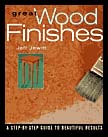

 A book review: By Bob Hamilton
A book review: By Bob Hamilton
Title: Great Wood Finishes
Author: Jeff Jewitt
Published by: Taunton
Press
ISBN 1561582883
Price Softcover: $22.95, 220 color pages
First Impressions: The cover of this
book is a real grabber. The background is a full-color, magnificently
figured burl finished to "pop" the grain and highlight
the beauty of the wood, but the finish stops short on the lower
right corner to show what the unfinished wood looked like. The
difference is amazing and is a very potent visual reminder of
how important the finish is in the overall impact of a project.
A quick flip through the pages showed the book is loaded with color photographs detailing the sequences described in the text. A glance at the index showed the book is well laid out, moving from tools and equipment through surface preparation, coloring, filling, applying, rubbing out, maintaining and repairing finishes. The final chapter puts everything together in actual finished pieces to give a better understanding of how to achieve the look you want.
In depth: the first section of the book deals with tools and equipment needed for both surface preparation and application of finishes. It moves from hand planes and scrapers through abrasives and fillers. The application tools begin with brushes, rollers and rags, and move on to spray equipment. The chapter describes what to look for in a tool and how to maintain it in good condition and prolong its life. There is even a plan for a knock-down spray booth to make spraying safer and more viable for those of us without the space for a conventional booth.
The first chapter of the second section deals with surface preparation and describes how to use the tools introduced in the first section. It also tells how to check the surface and how to repair blemishes and defects.
The next chapter deals with coloring the wood, including preparing to stain, the differences between dye and pigment stains, how to change the color including bleaching, and how to deal with problems.
Next we move on to filling the pores and how to use both oil based and water based pore fillers. Also included is how to color the filler to get the effect you want.
Chapter 6 is on glazing, toning and shading and also includes special effects like graining, highlighting and striating. Antiquing and distressing fall in this chapter as well.
The seventh chapter deals with applying finishes and describes how to get the best results whether brushing, wiping, padding or spraying oil based, alcohol based or water based finishes. It includes tips on holding parts while finishing and charts to troubleshoot problems with finishes.
Next is rubbing out finishes to achieve the desired sheen. This chapter begins with choosing the materials to use and includes instructions for rubbing out both thick and thin finishes. It describes both hand rubbing and machine buffing and how to deal with non-flat surfaces.
The next chapter deals with cleaning and repairing finishes to maintain or restore the appearance of the finish. It details the differences between waxes and polishes and the best way to repair damage to different kinds of finishes.
The final chapter is entitled "Specialty Finishes". It includes photo sequences from start to finish of over a dozen pieces of furniture, each with a different look. Each project starts with a reference to what materials are required to achieve the desired result and what sections of the book to review for the techniques use in that particular project.
It is fairly difficult to find anything negative to say about this book, but in the interests of constructive criticism:
There were a few instances where the limitations of photographic reproduction made it a little difficult to discern the point the author was trying to make. One particular example occurs on page 33 where the attempt is made to demonstrate that thinning a paint lets it act as a stain, allowing the grain of the wood to show through. Unfortunately my eyes could detect little difference between the two halves of the board. Perhaps a wood with a more prominent grain would have showed up better.
In the chapter on glazing, toning and shading, there are a few photo sequences which would have benefited from one more step. I would really have liked to see what the final result looked like instead of having the layouts stop at the dry brushing to blend stage. Frankly, at that point, the pieces still looked terrible to me and I can't imagine anyone wanting to make a project look like that on purpose. I am sure that later stages in the finishing process must improve the appearance, but I would have liked to have seen it.
Finally, and this is probably just me, I was disappointed to find no mention in the spray equipment section of low investment options like the Cricket spray gun. I would have liked to see a professional's opinion of whether acceptable results are achievable with this type of tool, or even tips for maximizing its performance. I am sure there are many amateurs like myself who have a compressor but could never justify the cost of a high end spray setup that would only be used half a dozen times a year.
Overall I thought this was an excellent book. It contains a lot of information that is well presented by an author who obviously knows his subject. I think it would be a valuable addition to any woodworking library.
Bob Hamilton
Editor's Note: You can purchase a copy of Jeff Jewitt's Book from Barnes and Noble for $18.36 (US)